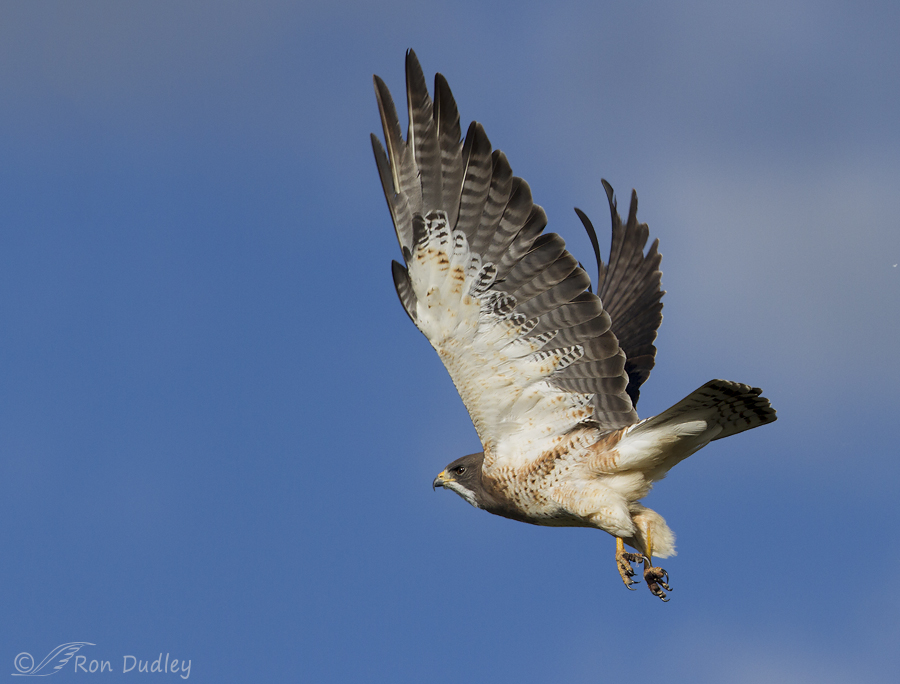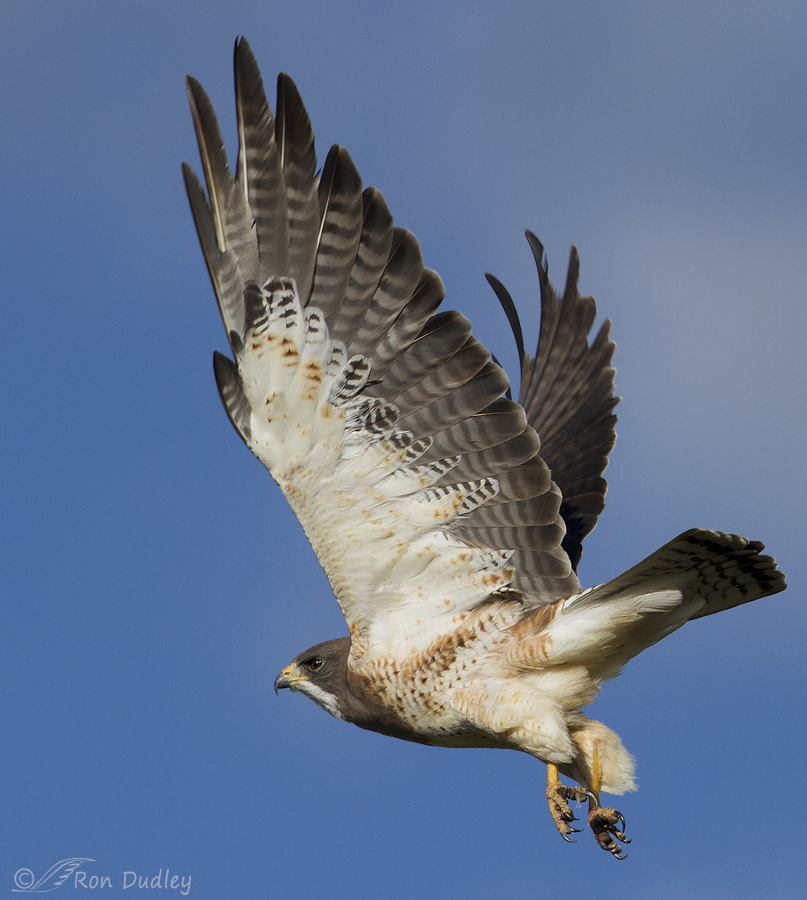Typically I tend to not be a fan of flight shots where the bird is already past me but though this Swainson’s Hawk has already done so I keep coming back to the image for a combination of reasons.

1/2500, f/6.3, ISO 500, Canon 7D, Canon EF500mm f/4L IS II USM, canvas added for composition, not baited, set up or called in
I photographed the hawk at the end of June in Clark County, Idaho as it lifted off from a telephone pole. There’s a slight head turn toward me that helps to make up for the angle I have on the bird and I like the detail, the flight posture, the light on the bird and the clouds in the background that make the blue of the sky a little more interesting. But I’m especially drawn to the plumage patterns and colors where the light-colored underwing coverts meet the base of the darker flight feathers. To my eye the contrast in colors, patterns and shapes is visually interesting.

1/2500, f/6.3, ISO 500, Canon 7D, Canon EF500mm f/4L IS II USM, not baited, set up or called in
Perhaps a ridiculously tight crop of the same image will help to highlight the feather patterns for the viewer.
I also notice two more interesting things about the bird – the open alula on the “wrist” of the left wing (to prevent stalling at the slow flight speeds of take-off) and the slightly unusual double catch-light in the eye. Multiple catch-lights are often caused as light from a low sun bounces off of a choppy water surface and into the eye but there was no water nearby so I have no idea what caused the effect here.
I wish I knew more about raptor plumages and molt because I’m curious about the uneven and deeply scalloped border between the wing coverts and remiges of this hawk – whether it’s caused by uneven growth of previously molted feathers or this is the normal appearance of those feathers after the molt is complete. So much to learn…
Ron


‘Visually interesting’!!! Have you turned English on me? That is an understatement that my British mama would have been proud of. Fascinating is closer to the mark. And with britches too…
I didn’t have to “turn” to be English, Elephant’s Child – my ancestry is English through and through (both maternal and paternal). The Barons Dudley of Dudley Castle are my ancestors. Ever heard of the book “The Uncrowned Kings of England – The Black History of the Dudleys and the Tudor Throne? – those sometimes unseemly characters are mine too. One of my ancestors was beheaded at the Tower of England. That stuff fascinates me. But gotta admit that I didn’t know that “visually interesting” was a phrase the English are known for…
Both of the Swainson’s hawks at Hawkwatch are dark morphs, so this is great to see. Thank you!
I still haven’t seen the HW Swainson’s, Tana. Someday…
Hi Ron, I appreciate this image for all the reasons given but especially for how clearly it shows the differing textures on the wing, aerodynamically perfect I am sure. The tightly “knit,” sharp leading edge blending to softness in what my book seems to call the “underhand.” It’s rare to see these things so well. I’ll sign up for Dick’s class, too. 🙂
Betsy, Too bad we don’t all live close and could actually attend such a class…
Swainson’s is a hawk we see around here with some regularity, and I recognize it in flight by the underwing patterns. So it’s very nice to be able to see the feather patterns up close. I’m really glad you posted these images.
Thanks very much, Susan.
The patterns are very eye-catching. I found myself trying to count dots and move feathers in my mind.
Thank you, Arwen.
Hi Ron,
Wonderful! This image would be perfect for a beginning “Hawk ID 101” class. I really like the way you have captured the contrast between the underwing coverts and the primaries, as well as the undertail coverts, slotted primary feathers, etc. Very, very nice! Thanks!
Cheers,
Dick
Wanna teach the class, Dick? I’ll sign up…
I think you’d be in the AP class, Ron. Upper division stuff…
🙂 🙂
I noticed the open alula, too….and then the contrast of darks and lights, sleek,smooth and fluffier textures, differing shapes and textures…variations not as evident in shots of other angles. I would like to know more about raptor molt, too…all I “know” is that they don’t molt as many feathers at one time as some other birds do…so they can remain as fully “operational” as possible…where’s Jerry Liguori when we need him?
I seldom see the alula identified in bird book diagrams…why??? It’s such an interesting feature…
“I seldom see the alula identified in bird book diagrams…why???”
I’m not sure, Patty but I suspect it’s because the alula usually isn’t easy to see because it’s typically tucked so tightly against the wing. The new Sibley Guide to Birds does have it labeled on a drawing (p. xix) but in that case it isn’t extended out so it isn’t very obvious.
I really like these flight shots for all the reasons you explained and you got the eye glint. A beautiful, powerful bird.
Thank you, Angela.
funny how Mother Nature sometimes hides her best work …
Interesting observation, Lois. I like it!
I’m very glad you chose to share these images. The power of the wings takes center stage, along with the beauty of the plumage and, of course, the eye light. Thanks.
I appreciate your encouragement, Alison. I almost didn’t share this one because I thought the things that interested me about the image might not have broad appeal.
Such sensational flight shots Ron! Thanks so much for sharing them!
Charlotte
Thanks, Charlotte.